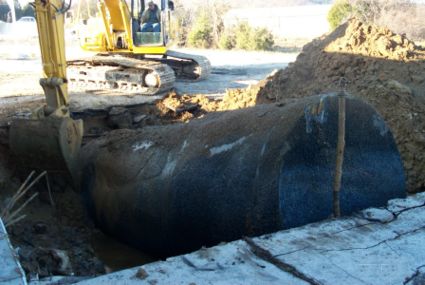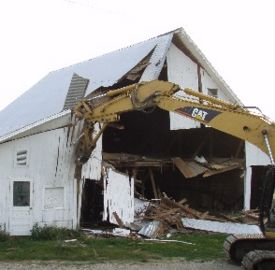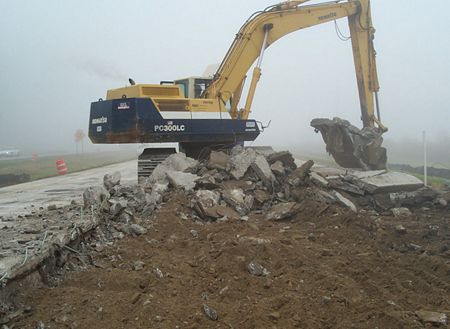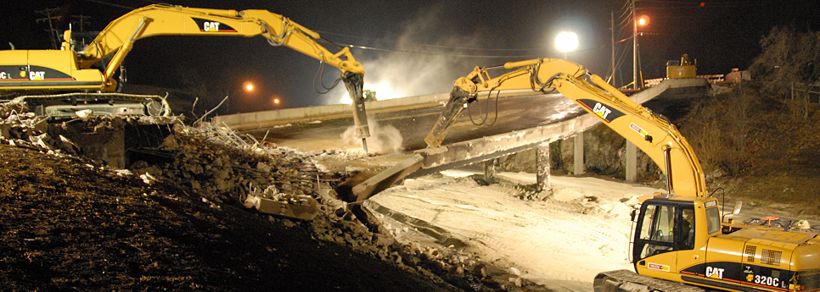Category:202 Removal of Buildings and Structures
The plans show the disposition of all existing facilities and structures within right of way limits, including buildings, bridges, drainage structures, foundations, sidewalks and existing surfaces. The standard specifications provide that all materials removed under construction contracts, except guardrail, become the property of the contractor, unless otherwise specified in the contract.
There are many aspects to be considered when inspecting construction quality and this article provides construction inspection guidelines.
Contents
- 1 202.1 Bridges
- 2 202.2 Removal of Improvements
- 3 202.3 Salvage Materials
- 4 202.4 Plans
- 5 202.5 Construction Inspection Guidelines for Sec 202
- 5.1 202.5.1 Tree Counting.
- 5.2 202.5.2 Description (for Sec 202.1).
- 5.3 202.5.3 General Requirements (for Sec 202.2).
- 5.4 202.5.4 Construction Requirements (for Sec 202.3).
- 5.5 202.5.10 Plugging and Closure of Wells (for Sec 202.10).
- 5.6 202.5.20 Septic Tank Plugging and Disposal (for Sec 202.20).
- 5.7 202.5.30 Removal of Improvements for Roadway Contracts (for Sec 202.30).
- 5.8 202.5.40 Demolition and Removal of Buildings (for Sec 202.40).
- 5.8.1 202.5.40.1 Description (for Sec 202.40.1).
- 5.8.2 202.5.40.2 Schedule (for Sec 202.40.2).
- 5.8.3 202.5.40.3 Demolition and Removal General Requirements (for Sec 202.40.3).
- 5.8.4 202.5.40.4 Removal of Asbestos Containing Material (for Sec 202.40.4).
- 5.8.5 202.5.40.5 Removal of Buildings (for Sec 202.40.5).
- 5.8.6 202.5.40.6 Removal of Appurtenances (for Sec 202.40.6).
- 5.8.7 202.5.40.7 Method of Measurement (for Sec 202.40.7).
- 5.8.8 202.5.40.8 Basis of Payment (for Sec 202.40.8).
- 5.9 202.5.50 Removal of Contaminated Material and Storage Tanks (for Sec 202.50).
- 5.10 202.5.60 Individual Wastewater Lagoon Closures (for Sec 202.60).
202.1 Bridges
The item for the removal of bridges is applicable to the removal of drainage structures with spans exceeding 20 ft. and other major structures, such as large retaining walls. The plans include a complete description, with dimensions, of the items to be removed under this specification. If the material resulting from the removal of these large structures is to be hauled and stored on maintenance lots, the plans provide a lump sum item for hauling materials to storage.
202.2 Removal of Improvements
This work consists of the removal and disposal of all existing improvements from the right of way and within the limits of any construction area outside the right of way, except for the following: existing improvements designated or permitted to be left in place; existing improvements included in Removal of Bridges; plugging or closure of wells, septic tanks, petroleum storage tanks or lagoons included as separate bid items; and existing improvements in excavation limits for Class 3 or 4 Excavation. (It should be noted, Class 3 or 4 excavation does not include removal of existing headwalls, culvert concrete or roadway culverts. These items should be handled as removal of improvements for roadway culverts or partial removal of culvert concrete for bridge culverts.) The designer intelligently estimates each item to produce a lump sum cost using the tabulated removal items. Plans may designate removals or salvaged materials from improvements. Salvaged materials may not be stored permanently on the right of way. The federal government will not participate in hauling removed improvements to stockpile sites.
202.3 Salvage Materials
It is not required to give salvage credits for minor items such as base, surfacing and culvert pipe on temporary bypasses. If it is determined that these minor items would be useful to the state, federal funds can participate in the cost of salvaging, if the cost does not exceed cost of new material and if work is limited to the setting aside (not stockpiling) of the materials on the right of way, beyond construction limits. The cost of salvaging materials by the contractor, stockpiling and/or delivery to a storage site cannot receive federal participation and requires identification by separate bid items to make costs non-participating.
The benefit of salvaged materials is generally questionable unless it is a major item. If any major materials are salvaged by the contractor, not used on the project and retained for use by the state, it will be necessary to give salvage credit if federal funds are involved. Examples of major items are traffic signals, guardrail and large culvert structures. Salvaged bridge materials may become the property of the contractor as specified in the standard specifications or may, by special provision, be retained by the commission without the necessity of giving salvage credit.
The special provisions should show what materials, except guardrail, are to be salvaged, if any, and should state the disposition to be made of the materials. The standard specifications state that guardrail materials remain the property of the Commission and shall be stored on the right of way as directed by the engineer. A salvage credit value should be established for all salvaged materials, if practicable, at the P.S.& E. stage. The value can be established by the engineer upon removal of the item, if it is anticipated that such value will be dependent upon the condition of the item after its removal. Salvage credit should be shown on the engineer's estimate.
202.4 Plans
The plans include a description of all known existing items to be removed. The items to be removed are noted on the plans by the letter "R". A tabulation of all known removal items is also included on the Summary of Quantities sheet. The removal items are listed in the order of occurrence insofar as practicable, designated by sheet number, station, location left or right with distance and a description. A total of the individual items is not indicated, since this is a lump sum item. Items to be left in place are noted "UIP" if they are to be used, and "LIP" if they are left in place and not used. Examples are shown in Sample Plans. Plans for all projects should be prepared to reuse material where the construction sequence will permit and where the cost of salvaging does not exceed the cost of new material.
202.5 Construction Inspection Guidelines for Sec 202
202.5.1 Tree Counting.
The Tree Replacement Program, which required counting of trees removed on construction projects, has been replaced with the Trees for Tomorrow program. In the new program, MoDOT funds the distribution of seedlings through the Missouri Department of Conservation rather than MoDOT counting destroyed trees and planting new ones.
202.5.2 Description (for Sec 202.1).
As specified.
202.5.3 General Requirements (for Sec 202.2).
MoDOT’s environmental section in Design will have made a detailed investigation of the right of way. They will have cleared the right of way of any known waste materials or made provisions for remediation of the waste site by either a roadway contract or a separate contract.
202.5.3.1 Unknown Waste.
If an unknown waste is discovered which was not covered by design's environmental report, the field inspector should proceed in accordance with the following steps:
- Step 1. Stop work in area of waste.
- Step 2.Contact the resident engineer and contractor's authorized representative or their designee.
- Step 3. The resident engineer or the resident engineer's representative shall contact by telephone at (314) 634-2436 and the Environmental Studies Coordinators (ESC) or his representative at Design by telephone at either (573) 526- 2904 or (573) 526-4764. The ESC will contact the Department of Natural Resources (DNR) Emergency Response Unit (ERU). Be prepared to assist DNR in filling out their Environmental Emergency Response Report. See Fig. No. 200.20. Attempt to obtain the spill report number from DNR. MoDOT's ESC should attempt to get a commitment from DNR ERU as to when they will inspect the site. After making report to DNR ERU and MoDOT's ESC, advise the district construction and materials engineer and the contractor's authorized representative or their designee as to how DNR is going to proceed. If DNR advises you they are taking immediate action, go to Step 4. If DNR advises you they will not investigate the site go to Step 10.
- Step 4. If DNR ERU is acting immediately, meet with them at the site. They will determine if the unknown waste is a hazardous waste or a solid waste. If hazardous they may or may not clean up the site. If DNR ERU proceeds with cleaning up the site go to Step 5. If DNR ERU declares it a hazardous waste but will not clean it up go to Step 6.
- Step 5. Cooperate with DNR and their cleanup efforts if a reasonable and appropriate request is made. However, MoDOT personnel will not be involved with any actual physical removal of any of the material involved with the cleanup. When DNR advises the site is clean, meet with contractor and determine if there is any additional work or compensation required and proceed with the contract work.
- Step 6. If the hazardous waste is not attributed to an underground storage tank go to Step 7. If it is attributed to an underground petroleum storage tank go to Step 8.
- Step 7. After it is determined where and how the hazardous waste is to be disposed of, the resident engineer will negotiate with the contractor to perform the work. The transportation of this material will have to be performed by a licensed hazardous waste transporter. The resident engineer or his representative along with the transporter will develop an appropriate manifest document that will be signed by a MoDOT representative. When all of the hazardous waste has been transported to a licensed hazardous waste disposal site the hazardous waste transporter shall furnish the resident engineer 3 copies of the manifest. Upon receipt of the original copy of the manifest the resident engineer will meet with the contractor and determine if there is any additional work or compensation required and proceed with the contract work.
- Step 8. If a petroleum underground storage tank is encountered , the resident engineer should advise the district construction and materials engineer and the Construction and Materials division as to the urgency of remediation of the site. If sampling and testing are required, the district construction and materials engineer (or a representative of the district construction and materials engineer) shall notify or contact Construction and Materials by FAX at (573) 526-5640 and provide the scope of work involved, tank location and Project Identification. After sampling and testing the site, Construction and Materials will submit the original report to the district construction and materials engineer with copies to Construction and Materials and the ESC in Design. The ESC will advise the district construction and materials engineer and RE on required additional procedures.
- Step 9. After the underground petroleum storage tank is removed the resident engineer shall furnish the ESC the information necessary for the department to file a closure report. The ESC will advise the resident engineer at the time whether or not to proceed with the contract work. Then the resident engineer will meet with the contractor and determine if there is any additional work or compensation required and proceed with the contract work.
- Step 10. The resident engineer should also furnish the district construction and materials engineer the same information furnished the DNR ERU and the ESC. After the waste has been removed in accordance with these guidelines the resident engineer and contractors representatives should determine if any additional compensation is due and proceed with the work. All demolition of structures, buildings, etc. will be covered by an active contract. If during the contractors performing this work should questions arise concerning suspect or additional suspect asbestos containing material in an area not covered by any active contract, contact Construction and Materials FAX 573 526-5240 with the scope of the problem and project identification. Construction and Materials will report back to the district on the status of the material. If the material is suspect than the resident engineer or his representative shall negotiate with the contractor (if qualified) to do this abatement. If the contractor is not qualified to do abatements or is not able to obtain a qualified subcontractor to perform the abatement then the resident engineer shall contact, through the district construction and materials engineer, the district design engineer who will prepare a new contract for the abatement. When an Asbestos abatement contract is completed, Construction and Materials shall be advised as soon as possible of the completed work in order to finalize the abatement records.
202.5.3.2 Disposal of Material (for Sec 202.2.1).
If the contractor elects to dispose of excess material, waste or products of clearing and grubbing on private property the contractor must obtain a written release from the property owner to document that the owner suffered no damage. A waste disposal agreement with the property should be executed before any materials are deposited on private property.
202.5.3.2.1 Construction Requirements for Sec 202.2.1.1 Forms that comply with the intent of the sample may be used.
202.5.3.2.2 Construction Requirements for Sec 202.2.1.2 If the contractor desires to dispose of materials or to stockpile materials within the limits of areas designated on plans as borrow easements, a waste disposal agreement is required. The state's rights in borrow easements pertain only to removal of excavation material.
202.5.3.3 Damaged Items (for Sec 202.2.2).
Sec 104.11.1 of the Standard Specifications requires the contractor to restore any property, adjacent and beyond the limits of the project, damaged by the prosecution of the work.
202.5.3.4 Dust and Emissions Control (for Sec 202.2.3).
As specified.
202.5.3.5 Salvage (for Sec 202.2.4).
All material designated in the contract to be salvaged for Commission use from existing structures or improvements shall be removed without damage, in sections that may be readily handled, transported and stored as approved by the engineer. Unless otherwise designated in the contract, coldmilled material shall remain the property of the contractor. Guardrail material will remain the property of the Commission and stockpiled as specified in the contract or as directed by the engineer. All buildings, material and equipment of any description not designated for salvage by the Commission shall become the property of the contractor, unless owned and claimed by a political subdivision or utility company. Salvaged material becoming the property of the contractor shall not be stored on the right of way, or shall any portion of the right of way or land owned by the Commission be used by the contractor as a place of sale for salvaged material designated in the contract or plans to be salvaged is to be removed without unnecessary damage in sections or pieces which may be readily transported and stored by the contractor at specified locations. Other material to be removed becomes the property of the contractor, unless owned and claimed by any political subdivision or utility company.
202.5.4 Construction Requirements (for Sec 202.3).
As specified.
202.5.4.1 Disposal of Material (for Sec 202.3.1).
Refer to EPG 202.5.3.2 Disposal of Material (for Sec 202.2.1).
202.5.4.1.1 Construction Requirements for Sec 202.3.1.1. Clean fill, including uncontaminated soil, rock, sand, gravel, concrete, minimal amounts of wood, metal and inert solids, as approved by rule or policy by DNR's Solid Waste Management Program, will not be regulated. These materials will not be considered solid waste, and may be disposed of without prior approval from DNR's Solid Waste Management Program. Any excess excavation resulting from the grading of the widened pavement and shoulders that cannot be disposed of within the project limits shall be, unless otherwise stated in the contract, disposed of at locations off the right-of-way furnished by the contractor. The Missouri Solid Waste Management Law and its ancillary regulations, 10 CSR 80-1 through 9, provided for the proper disposal of solid waste. MoDOT and its contractors must comply with the provisions of applicable regulations during highway and bridge construction activities. Refer to Construction Inspection Guidelines for Sec 201 for additional information in regard to “solid waste”.
202.5.4.1.2 Construction Requirements for Sec 202.3.1.2 These activities oftentimes involve the generation of "excess material", which in many instances can also be considered "solid waste" under the definitions of the Department of Natural Resources (DNR).Many types of excess material are not regulated by the DNR. Such "clean fill" includes uncontaminated soil, rock, sand, gravel, concrete, asphaltic concrete, cinder blocks, brick, minimal amounts of wood and metal and inert solids as approved by rule or policy by DNR. These materials are basically not considered solid waste, and may be disposed of without prior approval from DNR. Other substances that are not included in this list of materials may require special approval by the DNR prior to disposal in areas other than approved landfills.
Disposal of any other material which does not fit this "clean fill" definition must be in accordance with DNR (or local) regulations and it shall be the contractors responsibility to provide appropriate documentation (i.e. landfill receipts or private owner waiver statements) from DNR that the disposal will not violate applicable laws or regulations. Unless otherwise stated in the contract, no direct payment will be made for the contractor's compliance with this provision.
202.5.4.2 Removal Requirements (for Sec 202.3.2).
As specified.
202.5.4.3 Sewers and Drains (for Sec 202.3.3).
As specified.
202.5.4.4 Backfill (for Sec 202.3.4).
As specified.
202.5.4.5 Hazardous Material (for Sec 202.3.5).
As specified.
202.5.10 Plugging and Closure of Wells (for Sec 202.10).
202.5.10.1 Description (for Sec 202.10.1).
As specified.
202.5.10.2 Conformance Requirements (for Sec 202.10.2).
Plugging of drilled and dug wells is to be in accordance with the Code of State Regulations 10 CSR 23. After the well is plugged, it is necessary to submit a registration form with the appropriate fee to MDNR. This registration form can be obtained from the Department of Natural Resources. A copy of the completed form is to be furnished to the engineer.
202.5.10.3 Basis of Payment (for Sec 202.10.3).
As specified.
202.5.20 Septic Tank Plugging and Disposal (for Sec 202.20).
202.5.20.1 Description (for Sec 202.20.1).=
As specified.
202.5.20.2 Conformance Requirements (for Sec 202.20.2).
As specified.
202.5.20.3 Basis of Payment (for Sec 202.20.3).
As specified.
202.5.30 Removal of Improvements for Roadway Contracts (for Sec 202.30).
202.5.30.1 Description (for Sec 202.30.1).
As specified.
202.5.30.2 Method of Measurement (for Sec 202.30.2).
As specified.
202.5.30.3 Basis of Payment (for Sec 202.30.3).
As specified.
202.5.40 Demolition and Removal of Buildings (for Sec 202.40).
202.5.40.1 Description (for Sec 202.40.1).
As specified.
202.5.40.2 Schedule (for Sec 202.40.2).
As specified.
202.5.40.3 Demolition and Removal General Requirements (for Sec 202.40.3).
As specified.
202.5.40.3.1 Backfilling (for Sec 202.40.3.1). As specified.
202.5.40.3.2 Site Maintenance (for Sec 202.40.3.2). As specified.
202.5.40.3.3 Utilities (for Sec 202.40.3.3). As specified.
202.5.40.3.4 Site Security (for Sec 202.40.3.4). As specified.
202.5.40.4 Removal of Asbestos Containing Material (for Sec 202.40.4).
As specified.
202.5.40.4.1 Asbestos Identification and Testing (for Sec 202.40.4.1). As specified.
202.5.40.4.2 Licensing and Permits (for Sec 202.40.4.2). As specified.
202.5.40.4.3 Notification and Reporting (for Sec 202.40.4.3). As specified.
202.5.40.4.4 On-Site Supervisor (for Sec 202.40.4.4). As specified.
202.5.40.4.5 Regulated Asbestos Containing Material and Category I Nonfriable Asbestos Containing Material on Concrete (for Sec 202.40.4.5). As specified.
202.5.40.4.6 Unidentified Asbestos (for Sec 202.40.4.6). Refer to EPG 202.5.3.1 Unknown Waste.
202.5.40.4.7 No Salvage Permitted (for Sec 202.40.4.7). As specified.
202.5.40.4.8 Airborne Asbestos Particle Testing (for Sec 202.40.4.8). As specified.
202.5.40.4.9 Construction Requirements for Sec 202.40.4.9, Disposal. Refer to EPG 202.5.3.2 Disposal of Material (for Sec 202.2.1).
202.5.40.5 Removal of Buildings (for Sec 202.40.5).
As specified.
202.5.40.5.1 Demolition of Walls (for Sec 202.40.5.1). As specified.
202.5.40.5.2 Removal of Flooring (for Sec 202.40.5.2). As specified.
202.5.40.5.3 Disposal of Debris (for Sec 202.40.5.3). As specified.
202.5.40.6 Removal of Appurtenances (for Sec 202.40.6).
As specified.
202.5.40.7 Method of Measurement (for Sec 202.40.7).
As specified.
202.5.40.8 Basis of Payment (for Sec 202.40.8).
As specified.
202.5.50 Removal of Contaminated Material and Storage Tanks (for Sec 202.50).
Refer to EPG 202.5.3.1 Unknown Waste.
202.5.50.1 Description (for Sec 202.50.1).
As specified.
202.5.50.2 Schedule (for Sec 202.50.2).
As specified.
202.5.50.3 Removal Requirements (for Sec 202.50.3).
As specified.
202.5.50.3.1 Site Inspection (for Sec 202.50.3.1). As specified.
202.5.50.3.2 Conformance Requirements (for Sec 202.50.3.2). As specified.
202.5.50.3.3 Groundwater Monitoring Wells (for Sec 202.50.3.3). Refer to EPG 202.5.3.1 Unknown Waste.
202.5.50.3.4 Tank Vapor Levels (for Sec 202.50.3.4). As specified.
202.5.50.3.5 Tank Dewatering and Removal (for Sec 202.50.3.5). As specified.
202.5.50.3.6 Residual Material (for Sec 202.50.3.6). As specified.
202.5.50.3.7 Tank Pit Surface Water (for Sec 202.50.3.7). As specified.
202.5.50.3.8 Soil Excavation (for Sec 202.50.3.8). As specified.
202.5.50.3.9 Hauling and Disposal of Contaminated Soil (for Sec 202.50.3.9). As specified.
202.5.50.3.10 Use of Uncontaminated Soil (for Sec 202.50.3.10). As specified.
202.5.50.3.11 Water Accumulated in Excavation (for Sec 202.50.3.11). As specified.
202.5.50.3.12 Sample Analysis (for Sec 202.50.3.12). As specified.
202.5.50.3.13 Backfill (for Sec 202.50.3.13). As specified.
202.5.50.3.14 Closure Report (for Sec 202.50.3.14). As specified.
202.5.50.4 Method of Measurement (for Sec 202.50.4).
As specified.
202.5.50.5 Basis of Payment (for Sec 202.50.5).
As specified.
202.5.60 Individual Wastewater Lagoon Closures (for Sec 202.60).
202.5.60.1 Description (for Sec 202.60.1).
As specified.
202.5.60.2 Construction Requirements (for Sec 202.60.2).
As specified.
202.5.60.4 Basis of Payment (for Sec 202.60.4).
As specified.



